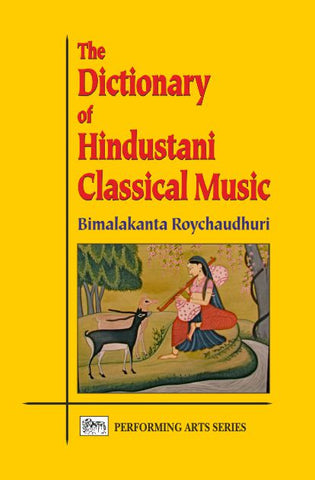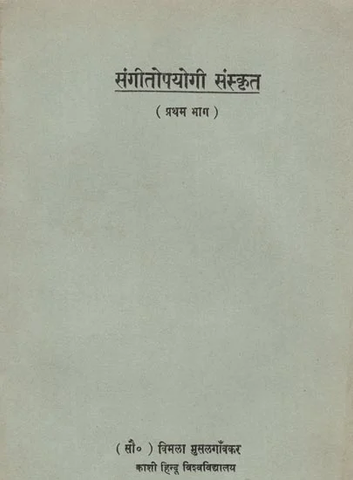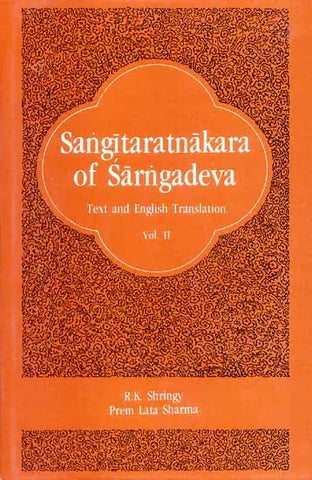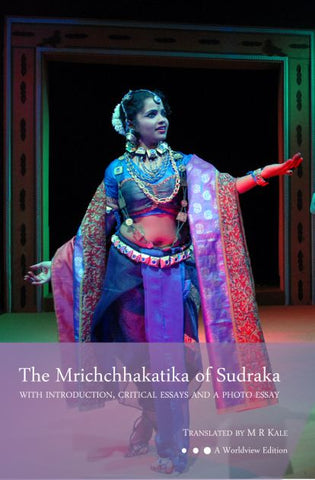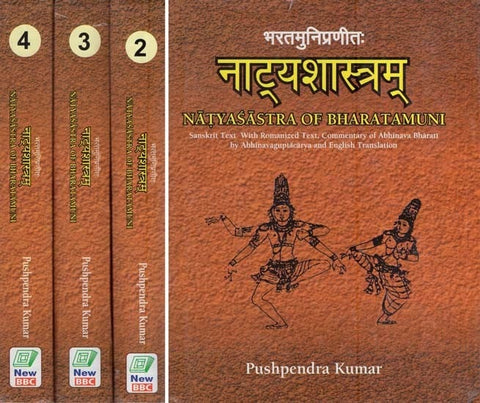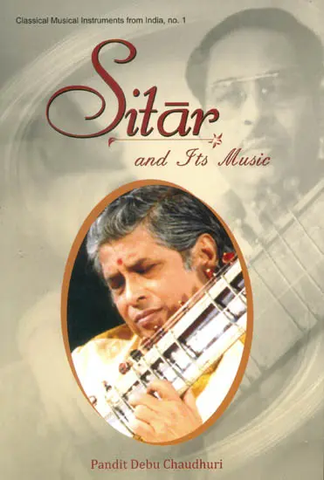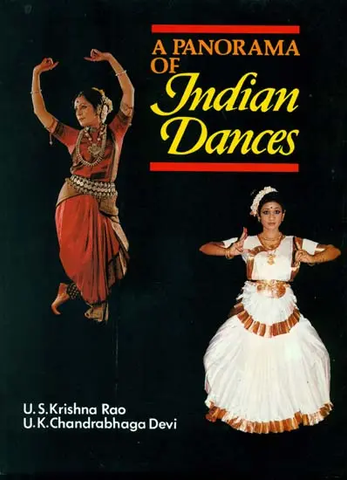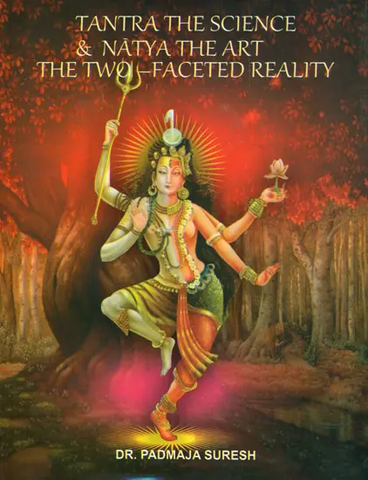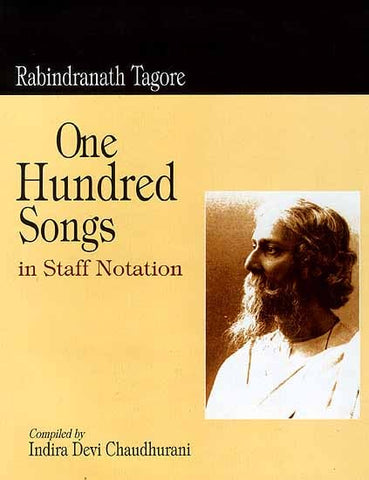Your cart is empty now.
The Matralaksanam (‘Description of Matra”) is one of the most important technical treatises belonging to the Kauthuma—Ranayaniya branch of the Samaveda. Because it deals not merely with textual and notational formation but with the chants as they are actually sung, the tract stands apart from such works as the Puspasutra and the Pancavidhasutra.
The unit of measure in the Samavedic chants is declared to the mantra, which is the duration of a short vowel. The existence of long, augmented, and prolated vowels is then set forth. However, the length of a syllable is determined not only by the duration of its vowel but also by the number of notational figures attached to the syllable. The treatise classifies syllables with two or more figures according to whether they do or does not have the time value of syllables found in the collection of source verses (arcika), where one-and-two-matra durations predominate.
Throughout his translation of the entire text and most of the commentary, the author has provided copious notes, which include 127 musical transcriptions of chant fragments pertinent to the various subjects addressed by the Matralaksanam. Following the translation he has attached a Translator’s Postscript, which relates the rules of the treatise to the ancient Indian’s concept of time. An Index of Samans and a General Index conclude the work.
Wayne Howard (b. 1942 Ph.D., Indiana University, 1975) began his study of the Samaveda in 1970, when he started a fifteen-month stay in India as a Fulbright Scholar. The first result of his field research was the publication of his dissertation, Samavedic Chant (Yale University Press, 1977). In addition to the Matralaksanam edition/ translation presented herein, Howard has written two other books: Veda Recitation in Varanasi (Motilal Banarsidass, 1986) and The Decipherment of the Samavedic Notation of the Jaiminiyas (Vol. 63 of Studia Orientalia; edited by the Finnish Oriental Society of Helsinki, Finland, 1988).
Howard has contributed articles and book reviews to the Indo-Iranian journal, The Journal of Asian Studies, the Journal of the American Oriental Society, the Academic American Encyclopedia and The World of Music, as well as to special publications such as Prof ER Sreekrishna Sarma Felicitation Volume, Dr BR Sharma Felicitation Volume, and Agni. The Vedic Ritual of the Fire Altar.
Presently he has planned several collaborations with other scholars, including the critical edition of the entire song corpus of the Jaiminiya Samaveda with Prof. Asko Parpola.
Kala Kosa Division of the Indira Gandhi National Centre for the Arts is the principal research and publication division. It will concentrate on the theoretical and textual tradition of intellectual discourse in the Indian artistic tradition. A distinctively Indian interdisciplinary system where the textual and the oral, the verbal and the visual, the scientific and the metaphysical, and the transcendental and the functional were interlocked as parts of a whole are recognized, but its concepts, structure and processes are often difficult to identify. The Indira Gandhi National Centre for the Arts aims to comprehend the arts, within the context of the Indian worldview, notions of space-time and interconnections at the level of theory and practice.
Emerging logically out of this perception are the four long-range programmes of this division, namely, (i) Kalatattvakosa — A Lexicon of Fundamental Concepts and glossaries of technical terms; (ii) Ka1ãmülaastra Series of fundamental texts basic to the Indian artistic traditions as also primary texts specific to particular arts; (iii) Publications, reprints, translations of works of critical scholarship such as those of AK. Coomaraswamy; (iv) Encyclopedia of the Arts — A multi-disciplinary, multi-volume Encyclopedia of the Arts.
The Kaltattvakosa is the first of these programmes, complex, and intricate in nature, but essential as a first prerequisite to identifying fundamentals of a rare holistic system.
The Kalamulasastra is the second programme. Here critical editions of originals and translations of fundamental texts relating to the Indian Arts ranging from architecture, sculpture, painting, theatre, music, and dance along with their scientific and technical commentaries will be undertaken. Attention in each of these volumes will be on the text unencumbered with the weight of some later obtuse commentaries and interpretations of a secondary nature. This series seeks to place the text in as exact a manner as possible by considering all primary material available in any part of the world. In each case, microfilm and microfiche of the manuscripts have been obtained and made available to the editor for collation and editing. It is hoped that a new methodology of critically editing and collating texts will be established through the publication of the series.
Matralaksanam is the first text to be published in this series. Perhaps it is one of the first attempts at transcribing the world’s most complex system of orally accented verses which were transmitted through oral intonation into a written textual form. The transcribing of a complex code of oral intonation preserved through a most exacting recitative discipline presents challenges in arriving at an authentic text. The present volume is based on six damaged or incomplete manuscripts of the Matralaksanam so far discovered, one printed edition in Grantha script (Krishnaswamv) and another in I3evandgari (BR. Sharma). Obviously, the authenticity of a text cannot be restricted in this case to a mere collation of diverse recensions of a written text. It was necessary to recheck the written text with the few traditional Samaveda chanters. Indeed, as is known, the rut4 i.e. the heard word has remained eternal and immutable in the Indian tradition while the written word has changed and is also subject to variations and inaccuracies. Matralaksanam thus is a true indicator of the relationship between the syllable and the intonated word, of the articulated sound and the written word. For the contemporary scholar, it is important to note that in the Indian tradition, the heard word was primary and the written secondary. Logically it leads to the deduction that the oral and the literate were not placed in a hierarchical framework of an evolutionary model of development from the oral to the literate. If so, then the broader classification of civilization being divided into pre-history and history on the basis of writing needs reassessment. Matralaksanam's importance is enhanced by the fact that it represents two very important Sakhas of Samaveda, namely, Ranayaniya and Kauthuma Sakhas. As is well known, Patanjali mentions nearly one thousand Sakhas of the Samaveda. Of these, only three are now extant in the living oral tradition. Of these three, there is a close similarity between the Ranayaniya and Kauthuma Sakhas in their mode of syllabic intonation as well as their manuals for recitation.
The contents of the Matralaksanam are of fundamental importance because this is perhaps the first text to discuss the concept of a time-unit measure (matra.). The importance of matra as a measure with the mathematical syllabic time value of vowels in their aspects of elongation, tempo, pitch and interval cannot be understood without taking into account sound as a measure. In delineating the semantic relationship between syllables and letters, vowels and consonants, it lays the foundation of disciplines today recognized as phonetics, linguistics and prosody. Equally important is the discussion on sound and notes, in doing so it is a forerunner of the ‘modal’ system of Indian music. As an exacting system of oral articulation and recitation, this text was used for recitation with hand gestures like arcika, In relating the articulation of sound with body language, and gesture, especially hands and fingers, the system of orally rendering a text according to its manuals, provides the basis of the emergence of a structure of artistic expression through the body (namely angikabhinaya). In more senses than one, Vedic intonation is a precursor of both theory and practice (sastra and prayoga) of the arts, in their original framework of interrelatedness.
Dr. Wayne Howard is an eminent scholar dedicated to Vedic studies and music. His earlier works have been acknowledged by Western and Indian scholars. It was not an easy task to arrive at an authentic text from different recensions and oral intonations of different regions, but he has accomplished this difficult task. By providing staff notation he has facilitated comprehension by those trained in Western techniques.
Despite its brevity, the preparation of the manuscript for publication, rechecking the text with traditional chanters, taking hard decisions of omitting passages of the text on account of faulty language etc. has been a difficult matter. Apart from the traditional Samavedic chanters, other scholars like Dr. B.R. Sharma had to be consulted. Dr. C.R. Swaminathan, an eminent scholar in his own right, and his young colleagues have rendered invaluable assistance. Thanks are acknowledged to D r. C.R. Swaminathan and Dr. C.B. Pandey, Editor, IGNCA, for supervising the complex bilingual publication and Mr. K. Khosa for the Jacket Design.
The Core Literature of the Samaveda
The essence of the Samaveda is chant’ (saman); in the Matralaksana (ML) the various laws regarding duration refer specifically to these melodies, which appear in notated form in four chantbooks (ganas). The ML uses quotations from the chantbooks to illustrate its rules.
Most of the chants draw their texts from the Erika, the collection of source verses (rc), which is divided into two parts. The first arcika (Purvarcika) contains verses addressed to the gods Agni, Indra, and Soma Pavamana, in that order. Each verse of the Purvarcika serves as the textual basis of one or more chants in the Gramageyagana (Village Chantbook). Attached to the end of this arcika is the Aranyakasamhita (Forest Collection), the verses of which are esoteric and philosophic in nature. The chants of the Aranyakagana (Forest Chantbook) make use of consecutive verses of the Aranyakasamhita, although chants based upon some Purvarcika texts are interspersed between. Intermingled with the chants on Purvarcika and Aranyakasamhita texts are those consisting entirely of stobhas, extra textual matter that, to varying degrees, infiltrates many chants. The Aranyakagana is divided into five sections (parvans: this term is used also for the “sections” of a chant) with the names arka, dvandva, vrata, and sukriya A fifth section, a supplement or parisista, is added at the end.
The chants of the Gramageyagana and the Aranyakagana are the basis (prakrti) for the derivative (vikrti) samans that occur in the other two chantbooks; hence the village and forest chants are sometimes called collectively the Prakrtigana. All of the melodies cited by the ML and its commentary are drawn from the Prakrtigana, although the present writer has utilized transcribed specimens from all four chant books for illustrative purposes. The Uhagana (Chantbook of Modified Secret [Melodies]: known also simply as the Rahasyagana) repeat melodies, albeit with occasional modifications, from the Gramageya- and Aranyakaganas, respectively. The sectional division of the Uha- and Uhyaganas is according to the duration of the rituals for which their chants are intended. These divisions have the names dasaratra, samvatsara, ekaha, and ahina; after them are the prayascitta and ksudra sections, which present samans sung for expiation and for carrying out some particular wish, respectively.
The relationship of the four chantbooks to the two arcikas is shown in the following outline.
I. Purvarcika + Aranyakasamhita
A. Prakrtigana
1. Gramageyagana (on Purvarcika texts only)
a. Agneya-parvan
b. Aindra-Parvan
c. Pavamana-parvan
2. Aranyakagana (on Purvarcika, Aranyakasamhita, and stobha texts) a. Arka-parvan
b. Dvandva-parvan
c. Vrata-parvan
d. Sukriya-parvan
e. Parisista
| Foreword | vii | |
| Preface | xiii | |
| Abbreviations | xvii | |
| Introduction | 1 | |
| Errors and Variant Readings | 7 | |
| Matralaksanam (Text and Translation) | 9 | |
| Chapter 1 | 11 | |
| Chapter 2 | 25 | |
| Chapter 3 | 33 | |
| Notes | ||
| Chapter 1 | 43 | |
| Chapter 2 | 75 | |
| Chapter 3 | 81 | |
| Translator’s Postscript | 89 | |
| Bibliography | 93 | |
| Index of Samans | 95 | |
| General Index | 97 |
Delivery and Shipping Policy
- INTERNATIONAL SHIPPING
- Rs.1000-1100/kg
- ESTD. Delivery Time: 2-3 weeks (depending on location)
- Bubble Wrapped with Extra Padding
- NATIONAL SHIPPING
- NCR: Rs. 30/half kg
- Standard: Rs. 80/half kg
- Express shipments also available on Request
- ESTD. Delivery Time: Ranging from 1-4 days up to 7 business days (Depending on your choice of Delivery)
- TRACKING
- All orders; national or international, will be provided with a Tracking ID to check the status of their respective orders
- Depending on the Shipping Service, Tracking ID may be used on their respective tracking portals
Frequently Asked Questions (FAQs)
Domestic Shipping: 3-4 Days (after shipping)
International Shipping: 1-2 weeks (based on your location)
You will receive an email once your order has been shipped or you can email us if you didn't receive tracking details (info@mlbd.co.in)
Every book that we sell is the latest edition except all the rare books
Yes, we do provide free shipping, only on domestic orders (within India) above Rs.1500


